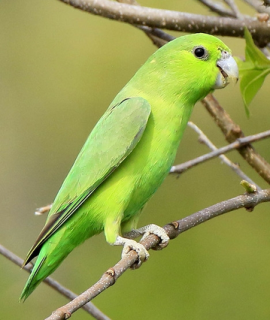Mexican Parrotlet |
|
|
Also known as: Blue-rumped Parrotlet, Turquoise-rumped Parrotlet, Sonora Parrotlet (F.c. pallidus), Grayson's Parrotlet (F.c. insularis)
Photos
View in GalleryDid You Know?
The Mexican Parrotlet wanders frequently in search of food, perhaps more than most parrotlets. This presents fluctuating numbers in any given area, making a quantitative assessment of this species difficult.Academic Research
Related publications: Forpus cyanopygiusSpecies Profile
Genus: Forpus | Species: cyanopygius
Size:
13cm (5 in)
Weight:
30g (1 oz)
Subspecies including nominate:
three: F.c. cyanopygius, F.c. pallidus, F.c. insularis
Colour Adult:
F.c. cyanopygius: Male-in general green in colour; turquoise/blue lower back, rump, and underwing coverts; blue secondary feathers, margined paler blue on outer webs of feathers; secondary coverts blue. Bill pale horn in colour. Eye brown. Female-yellow/green markings where is blue in male.
F.c. pallidus: Both adults in general paler than cyanopygius.
F.c. insularis: Male-darker green upperparts; blue/green underparts; darker blue on rump and lower back. Female-as in cyanopygius, but upperparts darker green.
Colour Juvenile:
F.c. cyanopygius: As in adults but young male has blue markings intermixed with green.
Call:
Calls made in flight or when perched a rolling series of squeaky notes; may be heard at some distance. While feeding occasional squawks.
Listen NowMore Information:
Content Sources:
CITES
BirdLife International
Cornell Lab of Ornithology/Birds of the World
Parrots: A Guide to Parrots of the World, Juniper and Parr, 1998
Parrots of the World, Forshaw, 2006. 2010 edition
Lexicon of Parrots, Thomas Arndt.
ML Media Collection Catalogue 8508, Mexican Parrotlet Forpus cyanopygius, Kincaid, Edgar, Jalisco, Mexico, Jun. 16 1957, Cornell Lab of Ornithology. Site
Photos
View in GalleryDid You Know?
The Mexican Parrotlet wanders frequently in search of food, perhaps more than most parrotlets. This presents fluctuating numbers in any given area, making a quantitative assessment of this species difficult.Academic Research
Related publications: Forpus cyanopygiusSpecies Care
Captive Status:
Fairly frequently seen in aviculture.
Longevity:
Up to 25 yrs.
Housing:
Planted large aviary 3 x 1 x 2m (9.8 x 3.3 x 6.5 ft) minimum; may be kept in communal aviary with other birds, but not other Forpus species.
Diet:
Fruits such as: apple, pear, orange, banana, cactus fruits, papaya, kiwi, mango; vegetables such as: carrot, celery, green beans and peas in the pod; green leaves such as: Swiss chard, lettuce, kale, dandelion, chickweed, sowthistle; rosehips; seed mix such as: wheat, oats, millets, weed seeds and a small amount of sunflower; insectivorous food for rearing young; complete kibble if taken.
Enrichment:
Provide unsprayed flowering, willow or elder branches for hiding in and chewing. Provide overhead misters and shallow water bowls for bathing. Provide many perches and ropes for climbing.
Nest Box Size:
Vertical nest box 15cm x 15cm x 25cm (4 x 4 x 10 in).
Clutch Size:
3 or more eggs.
Incubation Time:
19 days
Fledging Age:
4-5 weeks
Hatch Weight:
Not recorded.
Peak Weight:
Not recorded.
Weaning Weight:
Not recorded.
Photos
View in GalleryDid You Know?
The Mexican Parrotlet wanders frequently in search of food, perhaps more than most parrotlets. This presents fluctuating numbers in any given area, making a quantitative assessment of this species difficult.Academic Research
Related publications: Forpus cyanopygiusSpecies Wild Status
World Population:
< 50,000, decreasing.
IUCN Red List Status:
Near Threatened
CITES Listing:
Appendix II
Threat Summary:
Restricted-range species: found in Northwest Mexican Pacific Slope Endemic Bird Area (EBA). An estimated 8,000 individuals are captured illegally per year. Designated ‘Subject to Special Protection’ in Mexico.
Range:
F.c. cyanopygius: Sinaloa and W Durango south to Colima, Mexico.
F.c. pallidus: SE Sonora and N Sinaloa.
F.c. insularis: Tres Marias Islands, off coast of Nayarit.
Habitat:
Found up to 1300m (4264 ft) in gallery and deciduous woodland, plantations, scrub, semi-arid open country and cultivated areas with trees, mainly in lowland and foothills.
Wild Diet:
Diet includes Ficus fruits, berries and grass seeds taken from the ground.
Ecology and Behaviour:
Gregarious, forming flocks of 4-30 individuals, sometimes with Orange-fronted Conures (Eupsittula canicularis). Wanders locally in search of food. Will take seeds from the ground. Peak activity levels are first thing in the morning and late in the afternoon.
Clutch and Egg Size:
3 eggs
Breeding Season:
May-July; nest is presumably in tree cavity.
Photos
View in GalleryDid You Know?
The Mexican Parrotlet wanders frequently in search of food, perhaps more than most parrotlets. This presents fluctuating numbers in any given area, making a quantitative assessment of this species difficult.Academic Research
Related publications: Forpus cyanopygiusMembers Only Resources
Please log-in now to find more research, resources and tools.
Not a Member?
Find more great information:
Gain exclusive access to 600+ pages of additional research, seminars and podcasts, specialists to ask your toughest questions, and dozens of other fun resources - when you become a WPT member.
Join Today >>

































